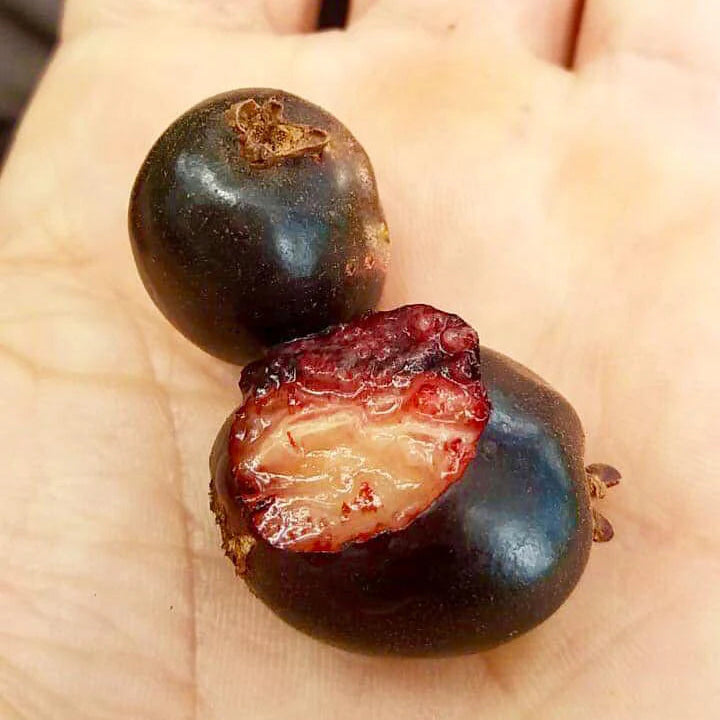Love it? Add to your wishlist
Your favorites, all in one place. Shop quickly and easily with the wishlist feature!
[message]
[title]
[message]


Veliyath Gardens
Couldn't load pickup availability
Botanical Name: Eugenia oblongata
Common Name: Cherry of the Paramirim
Family: Myrtaceae
Native to the Atlantic Rainforest of Brazil, Eugenia oblongata, commonly known as Cherry of the Paramirim, is a fast-growing evergreen shrub that gifts its caretakers with visually appealing, richly pigmented fruits. Bearing deep red to purplish berries, this little-known plant belongs to the large and diverse Eugenia genus, which includes numerous tropical and subtropical fruiting species.
Due to its sweet fruit, ornamental value, and resilience in varied climatic conditions, it has found a cherished place in fruit gardens and plant nurseries dedicated to preserving rare and exotic cultivars.
While globally recognized as Cherry of the Paramirim, the plant is also known by different names across its native and introduced regions:
Brazil: Cereja-do-Paramirim, Cerejinha Silvestre
Other parts of South America: Cereja de Mato (wild cherry)
In English-speaking tropical gardens: Rainforest Cherry, Brazilian Wild Cherry
Its fruits, though modest in size, are rich in flavor and nutrients—making this shrub a gem both for culinary exploration and ecological enhancement.
Size & Shape: Small, round to slightly oblong berries
Color: Transitions from dark red to deep purple upon ripening
Texture: Juicy and soft, with thin skin
Flavor: Sweet, mildly tart with a cherry-like taste; perfect for both fresh eating and processing
The fruits are typically enjoyed fresh but can also be transformed into preserves, sauces, or used as toppings for desserts.
The Cherry of the Paramirim fits beautifully into many culinary traditions. Its sweetness pairs well with savory and sweet dishes alike.
Fresh Snack: Enjoyed raw, straight off the plant
Jams and Preserves: Traditional Brazilian households often prepare tangy-sweet cherry jams
Desserts: Used in pies, pastries, ice creams, and syrups
Drinks: Juiced or infused into herbal teas and wellness tonics
Salads: Adds a fruity pop to green salads or grain bowls
The fruit’s versatility, paired with its health benefits, makes it a valuable addition to any kitchen or diet.
Like many berries, the Cherry of the Paramirim is densely packed with nutrients and bioactive compounds that support overall health.
Vitamin C: Strengthens immunity, boosts skin collagen, and promotes iron absorption
Potassium: Essential for heart health and fluid balance
Dietary Fiber: Supports digestive health and controls cholesterol
Polyphenols & Anthocyanins: Natural antioxidants that protect against cellular damage
Melatonin: Naturally occurring, may assist in improving sleep patterns
Heart Health: Helps regulate blood pressure and reduces inflammation
Anti-inflammatory: Aids in reducing muscle soreness and exercise-related fatigue
Diabetes Management: Fiber and antioxidants support blood sugar regulation
Cognitive Protection: Antioxidants may delay age-related mental decline
Skin Support: Vitamin C and polyphenols promote radiant, youthful skin
Sleep Aid: Thanks to natural melatonin content, cherries may help enhance sleep quality
This makes the fruit not only a delicious delight but a smart and holistic choice for wellness seekers.
Cherry of the Paramirim is a rewarding plant for home gardeners, whether for its edible harvest or ornamental beauty.
Evergreen shrub, moderately bushy
Ideal for small to medium garden spaces
Also suitable for container growing
Thrives in tropical and subtropical climates
Requires full sun to partial shade
Prefers well-drained, fertile soil with good organic content
Requires regular watering, especially in dry spells, but does not tolerate waterlogging
Begins to flower and fruit within 2–3 years
Small white flowers are fragrant and pollinator-friendly
Bears fruit seasonally once mature
Moderate—Regular pruning, mulching, and fertilizing help the plant maintain vigor and enhance fruit production.
In Brazil, this plant is often grown near forest edges or in agroforestry systems to maintain biodiversity and provide food for local wildlife. It is also appreciated for its role in reforestation efforts and pollinator support, offering habitat and nectar for native bees and butterflies.
Furthermore, the presence of this fruit in traditional diets reflects a deeper connection between people and the rainforest—where nutrition, culture, and sustainability coexist.
Why Add Cherry of the Paramirim to Your Garden?
🌿 Rare and beautiful: A unique plant not commonly found in typical nurseries
🍒 Sweet and nourishing fruits: Delicious and versatile
🌺 Ornamental and edible: Blossoms and berries bring beauty and utility
💚 Eco-conscious gardening: Supports biodiversity and wildlife
🏡 Perfect for tropical gardens: Easy to grow and fast to fruit
Veliyath Gardens is proud to offer this rare and delightful fruiting shrub to those who value uniqueness, health, and ecological beauty. The Cherry of the Paramirim (Eugenia oblongata) invites you to experience a taste of the tropics while supporting sustainable planting.
Add it to your fruit garden, share its cherries with family, and savor the joy of cultivating something truly special.
Let this charming cherry plant enrich your landscape and your life—only at Veliyath Gardens.
Prefers well-drained, fertile soil with good organic content
Requires regular watering, especially in dry spells, but does not tolerate waterlogging
Blooming and Fruiting:
Begins to flower and fruit within 2–3 years
Heart Health: Helps regulate blood pressure and reduces inflammation
Anti-inflammatory: Aids in reducing muscle soreness and exercise-related fatigue
Diabetes Management: Fiber and antioxidants support blood sugar regulation
Cognitive Protection: Antioxidants may delay age-related mental decline
Rare and beautiful: A unique plant not commonly found in typical nurseries
🍒 Sweet and nourishing fruits: Delicious and versatile
🌺 Ornamental and edible: Blossoms and berries bring beauty and utility
💚 Eco-conscious gardening: Supports biodiversity and wildlife



